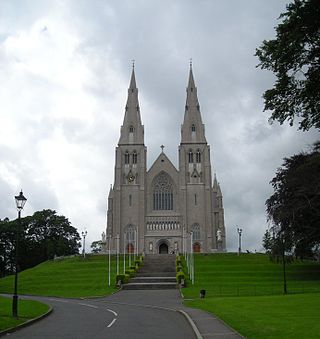
Lionel of Antwerp, Duke of Clarence,, was an English prince, Earl of Ulster jure uxoris from 1347, Duke of Clarence from 1362, Guardian of England in 1345-1346, Lord Lieutenant of Ireland in 1361-1366, Knight of the Garter from 1361, second surviving son of King Edward III of England and Philippa of Hainault. He was named after his birthplace, at Antwerp in the Duchy of Brabant.

The Archdiocese of Armagh is a Latin ecclesiastical territory or archdiocese of the Catholic Church located in the northern part of Ireland. The ordinary is the Roman Catholic Archbishop of Armagh who is also the Metropolitan of the ecclesiastical province of Armagh and the Primate of All Ireland. The mother church is St Patrick's Cathedral. The claim of the archdiocese to pre-eminence in Ireland as the primatial see rests upon its traditional establishment by Saint Patrick circa 445. It was recognised as a metropolitan province in 1152 by the Synod of Kells.
The Treasurer of the Chamber was at various points a position in the British royal household.
Events from the 1360s in England.

John Bokyngham was a medieval treasury official and Bishop of Lincoln.
Milo Sweetman was a fourteenth-century Irish Archbishop of Armagh, who was noted for his fierce defence of the privileges of his archdiocese.
The Lord High Treasurer of Ireland was the head of the Exchequer of Ireland, and chief financial officer of the Kingdom of Ireland. The designation High was added in 1695.
Richard Northalis was an English-born cleric and judge who spent much of his life in Ireland. He held the offices of Bishop of Ossory, Archbishop of Dublin and Lord Chancellor of Ireland. For the last decade of his life, he was one of the English Crown's most trusted advisers on Irish affairs.
Robert Wikeford or de Wikeford was an English-born diplomat, lawyer and judge, who became Lord Chancellor of Ireland and Archbishop of Dublin.
Richard Talbot was an English-born statesman and cleric in fifteenth-century Ireland. He was a younger brother of John Talbot, 1st Earl of Shrewsbury. He held the offices of Archbishop of Dublin and Lord Chancellor of Ireland. He was one of the leading political figures in Ireland for more than thirty years, but his career was marked by controversy and frequent conflicts with other statesmen. In particular, the Talbot brothers' quarrel with the powerful Earl of Ormonde was the main cause of the Butler–Talbot feud, which dominated Irish politics for decades, and seriously weakened the authority of the English Crown in Ireland.
John de St Paul, also known as John de St. Pol, John de Owston and John de Ouston, was an English-born cleric and judge of the fourteenth century. He was Archbishop of Dublin 1349–62 and Lord Chancellor of Ireland 1350–56. He had previously been Master of the Rolls in England 1337–40. Apart from a brief period of disgrace in 1340, he enjoyed the confidence of King Edward III. He was described as a zealous supporter of English rule in Ireland, but also as a pragmatic statesman who was willing to conciliate the Anglo-Irish ruling class. He did much to enlarge and beautify Christ Church, Dublin, although virtually no trace of his improvements survive, as they were destroyed by the Victorian rebuilding of the cathedral.
Thomas le Reve was the first Bishop of Waterford and Lismore following the unification of the two sees in 1363, and was also Lord Chancellor of Ireland. He was a strong-minded and combative individual, who was not afraid to clash with his ecclesiastical superiors.

Thomas de Everdon was an English-born cleric and judge, who was a trusted Crown official in Ireland for several decades.
John de Burnham, or John Brunham was an English-born cleric, judge and Crown official who spent much of his career in Ireland. He held office as Lord High Treasurer of Ireland and Chief Baron of the Irish Exchequer. He spent many years defending himself against charges of corruption, which seem to have been the invention of malicious colleagues.
William de Karlell was an English-born judge, administrator and cleric in fourteenth-century Ireland. He held numerous benefices including Archdeacon of Meath and Rector of Youghal, and sat in the Irish House of Commons. After sitting for some years as a Baron of the Court of Exchequer (Ireland) he was removed from office, following a flood of complaints about his acts of extortion and oppression committed by himself and Chief Baron Holywood, but he was later restored to favour, and served briefly as Chief Baron of the Irish Exchequer. He is buried in St Canice's Cathedral, Kilkenny.
Nicholas Lumbard or Lombard was an Irish barrister and judge of the fourteenth century.
John de Karlell was an English-born cleric, civil servant and judge in fourteenth-century Ireland. He served as second Baron of the Court of Exchequer, and as Chancellor of the Irish Exchequer. He became Chancellor of St Patrick's Cathedral, Dublin, after a struggle for the office with his colleague Walter de Brugge.





